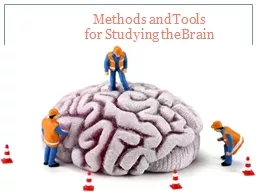

Techniques to study the brain A brain lesion experimentally destroys brain tissue to study animal behaviors after such destruction disease Microelectrode Techniques Very small electrodes inserted into individual neurons ID: 911413
Download Presentation The PPT/PDF document "Methods and Tools for Studying the Brai..." is the property of its rightful owner. Permission is granted to download and print the materials on this web site for personal, non-commercial use only, and to display it on your personal computer provided you do not modify the materials and that you retain all copyright notices contained in the materials. By downloading content from our website, you accept the terms of this agreement.
Slide1
Methods and Tools for Studying the Brain
Slide2Techniques to study the brain
A brain
lesion
experimentally destroys brain tissue to study animal behaviors after such destruction (disease)
Slide3Microelectrode TechniquesVery small electrodes inserted into individual neurons
Used to study activity of a single neuron
Slide4Macroelectrode Techniques
Used to get a picture of overall activity in the brain
EEG (
Electroencephalogram)
uses electrodes placed on a person’s scalp to measure a
n amplified recording of the electrical waves sweeping across the brain’s surface.
Slide5Structural ImagingComputerized Axial Tomography (CAT-scan)
Uses X-rays to create a 3-dimensional image of the brain
CT scans can often show the size and locations of brain abnormalities caused by tumors, blood vessel defects, blood clots, strokes and other problems.
Slide6Structural Imaging cont’d
Magnetic Resonance Imaging (MRI)
Uses a magnetic field and radio waves to produce
computer-generated images
They distinguish among different types of brain tissue.
Image shows ventricular enlargement in a schizophrenic patient.
Slide7CT Scan vs. MRICT may be less expensive than MRI. In addition, it is less sensitive to patient movement.
CT can be performed if you have an implanted medical device of any kind, unlike MRI.
MRI contrast materials used for image enhancement have very low incidence of side effects
Slide8Functional ImagingShows the brain functioning in real time (movies or series of images)
Positron Emission Tomography (PET) and Single Photon Emission Computed Tomography (SPECT)
Use radioactive glucose to determine location of greatest brain activity
PET Scan of Alzheimer's Disease Brain
PET Scan of Normal Brain
Slide9Functional ImagingFunctional Magnetic Resonance Imaging (
fMRI
)
Shows function and structure by measuring movement of blood molecules within the brainWIRED SCIENCE | Lie Detectors | PBS
https://www.youtube.com/watch?v=KNumpFy58Bk